As World War II ended in August 1945, the Soviet Union added another country to its list of gains:the northern part of the Korean Peninsula. Stalin planned to make Korea a similar satellite to Poland, East Germany or Hungary, but something went very, very wrong ...
Let us remind you that the US - fearing that the war with Japan would last much longer - asked the Russians themselves to take control of North Korea. The US was simply about providing a temporary administration in one of the Japanese colonies.
The Soviets saw things differently, although their intentions from the beginning seemed doomed to failure:Korea was far from Moscow, no one had heard of communism there before, there were no workers' parties, and the population was attached to a racial, fascist vision of the world, effectively instilled in by the Japanese.
Even among Poles - who perfectly remembered the war with the Bolsheviks twenty-five years ago - communism fell on more fertile ground in 1945. Well, let's start from the beginning.
A Bolshevik Dish (I mean the State) in five minutes
The Soviets wasted no time. Already in August 1945, they occupied the territory of North Korea, and located their main base in the ancient city of Pyongyang (Pyongyang). They immediately formed the Korean Labor Party, transferring ownership of publishing houses, printing houses and radio stations to it.
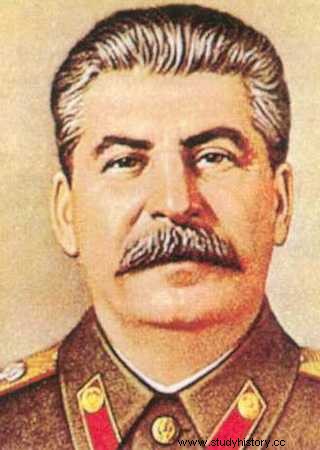
Even though the vassalisation of Korea seemed doomed to fail from the beginning, Stalin was not going to give it up anyway.
In September, the first issue of the party organ ("Rodong sinmun") was released, and in October it began broadcasting. The first broadcast showed - oh how! - the capital rally in honor of the Soviet liberators.
Everything was going according to a plan that worked perfectly in Central and Eastern Europe. As B.R. Myers, author of The Purest Race. North Korean Propaganda ":
Soviet authorities ordered a "people's revolution" (...). The first stage was a coalition between the communists and other powers, then followed a pseudo-coalition in which the communists dealt cards, and then the last stage - the monolithic regime (p. 25).
Chief by chance
There was only one problem:there was absolutely no one in Korea to lead such a revolution . For lack of a better candidate, a rather random Korean soldier who had spent the entire war in the Soviet Union was chosen:one Kim Il-sen. As it soon turned out, it wasn't a very good idea.
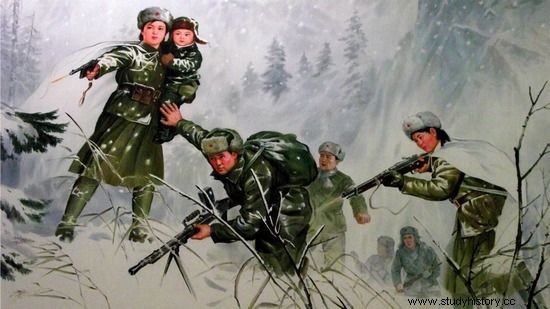
Contrary to North Korean propaganda, Kim Il-sung did not fight the Japanese in Korea at all. In fact, from 1941 he stayed in the USSR, where he commanded only a battalion of his countrymen. He also completed a one-year course at the NKVD school there. The picture shows a propaganda poster showing Kim Il-sen, with his wife and little son during the attack on Japanese positions.
Kim Il-sung, contrary to the myths created later, never commanded partisans and never fought in Korea against the "Japanese invader". He was born in Pyongyang, but quickly moved north, where he joined Mao Zedong's Chinese troops.
He was even famous for his attack on a Japanese outpost in 1937, but it is hard to say that he fought for Korea in this way. Anyway, he did not record any further successes on his account, because he spent World War II in an agricultural town far from the front lines. More importantly, he was neither a particularly intelligent nor educated man .
B.R. Myers put it even more bluntly. In his opinion, Kim Il-sung was certainly the least educated of all the leaders in the socialist world (p. 26) . He left school at the age of seventeen, and although he later took a one-year officer course in the Soviet Union, he doesn't seem to have learned much, hoping that he knew little Russian.
Years later, a German translator working for him during his visit to East Berlin recalled that the Korean commander had made an impression on her of a man who never in his life hasn't read any serious book (p. 26) .
Of course, history teaches that a chief's intelligence is actually a secondary matter - it is important that his aides and advisers know what they are doing. Meanwhile, no one in Korea knew about it :finding people who had an idea of Marxism-Leninism or the class struggle was like digging behind a needle in a haystack.
An accelerated ideological course for members of the Labor Party was not conducted until 1948, three years after the start of the "People's Revolution"! By then it was too late to put North Korea (from September:Democratic People's Republic of Korea) on the proper course.
Communist… fascism?
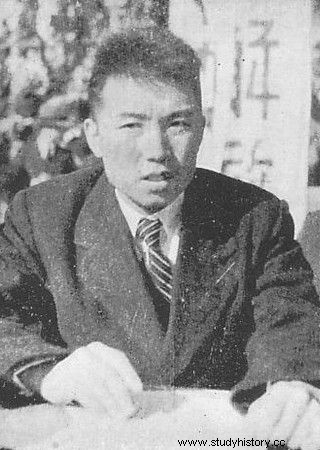
Kim Il-sung became the leader of North Korea by virtue of accident. Here in the photo from 1946
Due to the lack of his own specialists, Kim Il Sung left the propaganda apparatus in the hands of ... the same people who worked in it under the Japanese occupation.
No wonder that all communist slogans (about class struggle, typicality, socialist, socialist realism, etc.) served only as a facade:in fact, they created nationalist, racial and even fascist an ideological system according to which Koreans are the most perfect and purest race in the world, surrounded by people who are morally imperfect.
The effects began to emerge even before the Korean War of 1950-1953. It was enough that the Red Army withdrew from the peninsula (in 1948), and the worship of Kim Il-sung overshadowed adoration for Stalin himself - the university was named after the leader, his native village was made a national sanctuary, and monuments were erected in every second town.
The war, surprisingly, did not change much here:although Kim Il-sung had become even more dependent on the Soviets and the Chinese, but instead of beating loyal obeisances, he was increasingly isolating his country.
Officially, he still thanked the Soviet authorities (he even said that to love the USSR means to love Korea ), but in the 1950s the number of works translated from foreign languages was clearly limited and the staging of Soviet plays was completely banned. Any successes were portrayed in domestic propaganda as the achievements of Koreans who did not benefit from any foreign aid.
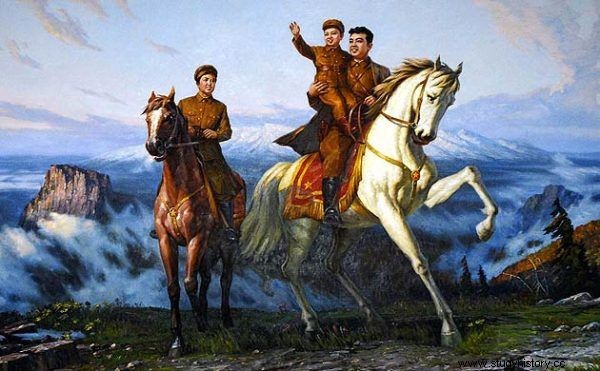
Kim Il-sung on his white horse. Symbol taken directly from the Japanese who presented Emperor Hirohito in this way, to emphasize the purity of his race.
Allies from the USSR were described as helpful people, but inferior, morally and racially imperfect . As reported in his book by B.R. Myers: The purity of Korean blood was emphasized. Women who married humanitarian workers in Eastern Europe were accused of "betraying their race". Anyone with an emotional connection to the outside world became suspect (p. 35).
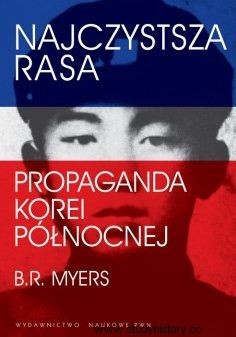
However, this is just the tip of the iceberg. After all, most of the countries of the Eastern bloc looked at their neighbors with a certain reserve (for example, Poland in the GDR). The real picture of the situation in Korea - which was nothing like a communist state - only emerges from the accounts of foreigners who visited her with humanitarian and economic aid. B.R. Myers continues:
Eastern European diplomats (...) reported xenophobia in Pyongyang. Some people have encountered insults and stones being pelted by children in the street.
Koreans or Koreans who associated with Europeans were forced to divorce - otherwise they were chased out of the capital ( the East German embassy in internal letters compared these practices to practices of Nazi Germany ).
The Soviet wife of a Korean citizen was beaten unconscious by the provincial police while trying to reach Pyongyang. In 1965, when the black ambassador of Cuba to the DPRK was showing his wife and Cuban doctors the city, the locals surrounded their car, hitting it with whatever they could and throwing racist epithets at passengers (p. 36) .
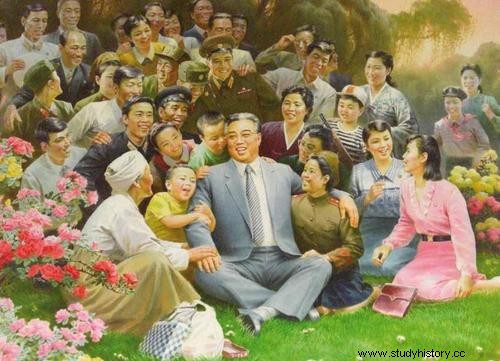
The regime created by Kim Il-sung really has little to do with communism. He is closer to Nazi Germany than to the Stalinist Soviet Union. One of hundreds of propaganda posters depicting Kim Il-sung as the father of the nation is shown here.
Until the beginning of the 1990s, such a regime was subsidized by the Soviet Union and the demolished people (including Poland!). Let us add that the same regime is still referred to as the communist and Stalinist regime. And this is probably a misunderstanding.
Source:
The article is based on the book by B.R. Myers "The purest race. North Korean Propaganda ”published by PWN (more information on the publisher's website).
